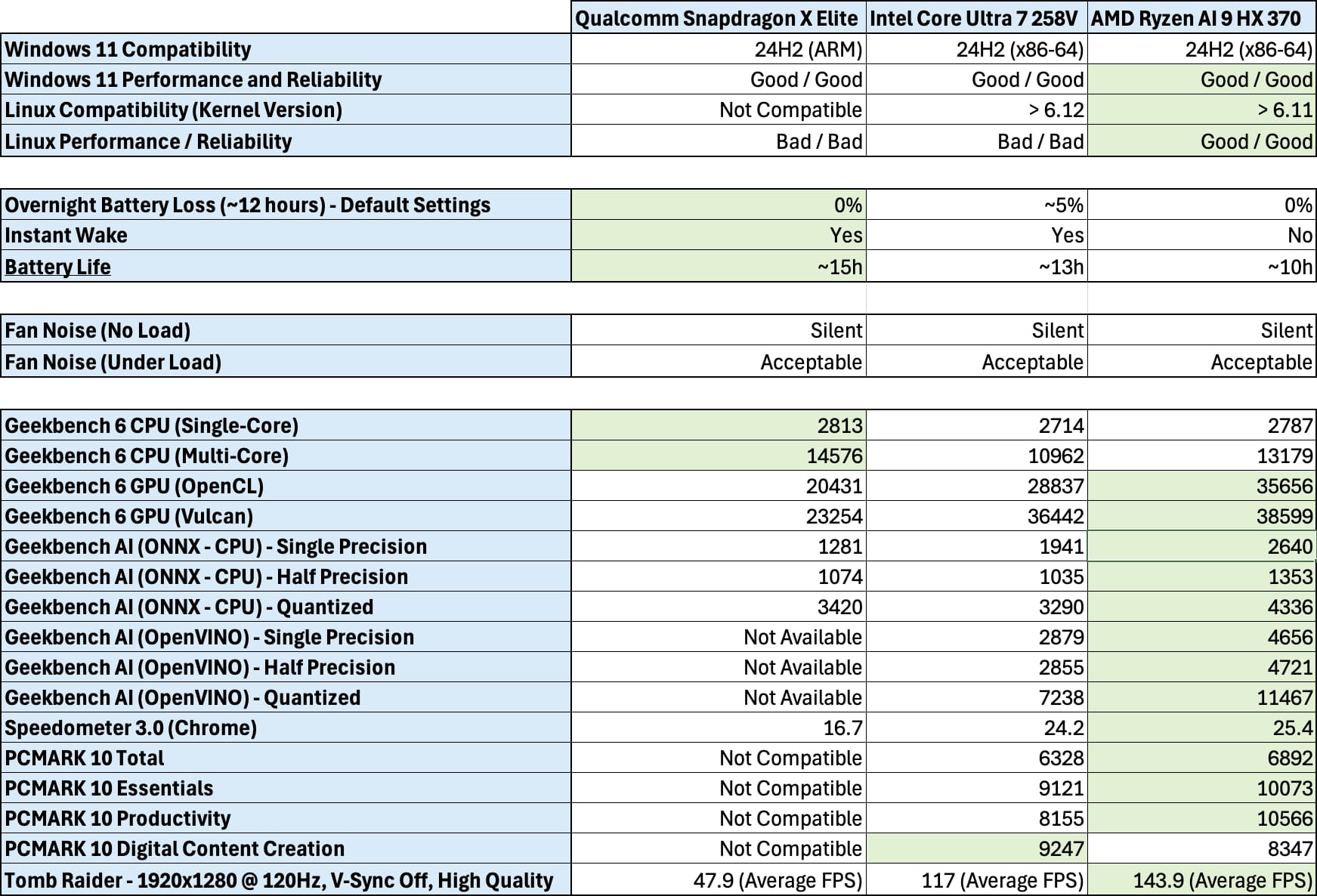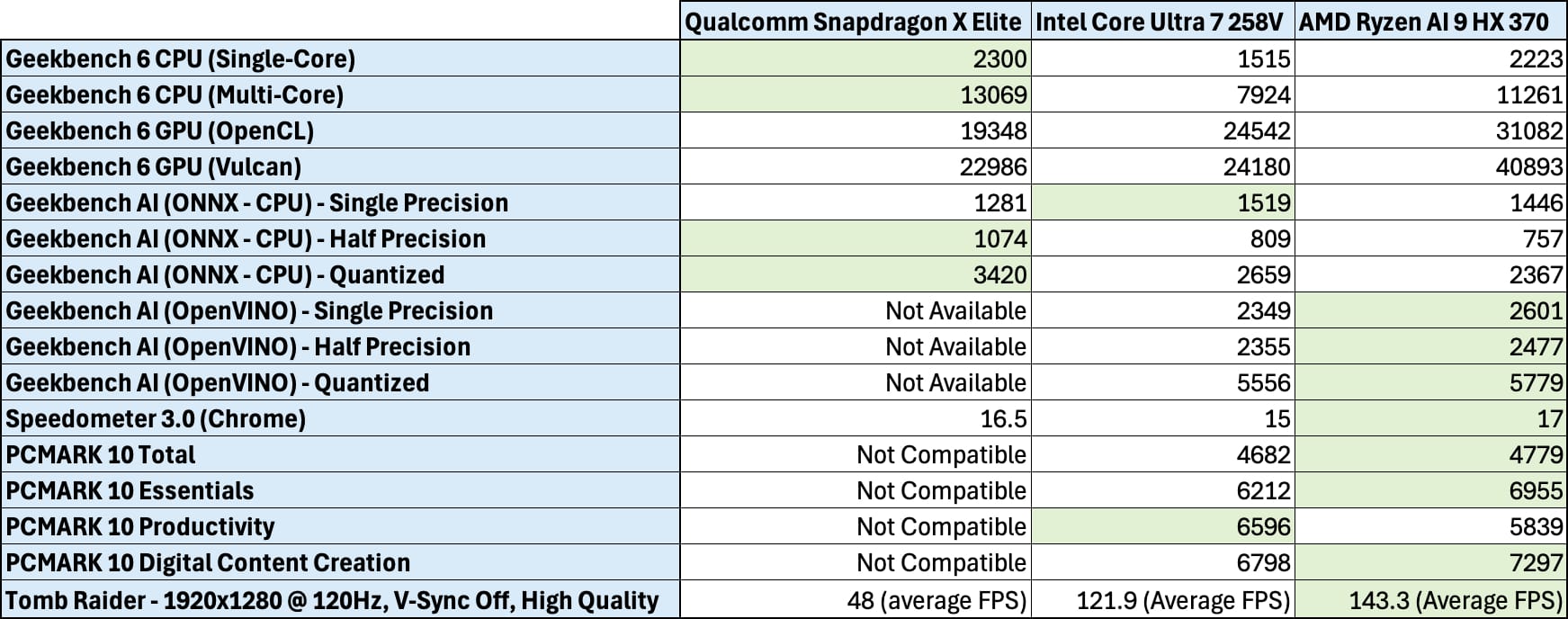Intel Lunar Lake
In my recent article “Chip Wars”, I shared my perspective regarding the recent turbulence across the PC silicon market.
With the release of Intel Lunar Lake, formally known as Intel Core Ultra (Series 2), we now have the full picture, covering Qualcomm, Intel and AMD.
Specifically, I have had access to a Microsoft Surface Laptop 7 (Qualcomm), Asus Zenbook S 14 (Intel), and Asus Zenbook S 16 (AMD). Although these laptops are not like-for-like, they do offer insights into how each of the new architectures perform.
All laptops were equipped with 32GB RAM and a 1TB SSD. The specifications of each system-on-a-chip can be found below.
- Qualcomm Snapdragon X Elite - X1E-80-100 (12C/12T, 4.2GHz Max, 45 TOPS)
- Intel Core Ultra 7 258V (8C/8T, 4.8GHz Max, 47 TOPS)
- AMD Ryzen AI 9 HX 370 (12C/24T, 5.1GHz Max, 50 TOPS)
On paper, the AMD Ryzen AI 9 HX 370 is the most powerful system-on-a-chip, with the most cores, threads, boost clock frequency and the highest rated Neural Processing Unit (NPU).
It is evident from the design that Intel has prioritised power efficiency with Lunar Lake, reducing the number of cores and removing hyper-threading. The Intel Core Ultra 7 258V has a total of eight cores, but only four are focused on performance.
Outlined below are the results from my testing, covering common and specialist workloads. Knowing that power can have a direct impact on performance, I also tested each laptop whilst on battery.
The first series of tests were completed when connected to mains power.

The second series of tests were completed when battery-powered.

As an immediate observation, the tests highlight a weakness of the Qualcomm Snapdragon X Elite regarding software compatibility due to the immaturity of Windows on ARM (something that I hope will improve over time). This can be seen with the results for PCMARK 10 (not compatible) and Tomb Raider (x86-64 translation).
Overall, I am excited to see that Qualcomm, Intel and AMD have all produced compelling products, each delivering significant improvements over the previous generation, with ~20% better performance, ~40% better battery life and dramatically lower thermal characteristics (reduced cooling requirements and fan noise).
In addition, they all meet the minimum requirement for “Copilot+ PC”, including a Neural Processing Unit (NPU) with a minimum of 40 TOPS. Currently, the real-world value of “Copilot+ PC” is minimal. However, I expect to see increased utilisation over the coming months/years. For example, there are rumours that Microsoft plans to offload Microsoft Teams features to the NPU, which should have a positive impact on performance and battery life.
Based on the results, it is evident that Qualcomm delivers exceptional processor performance (single and multi-threaded) when operating on mains power and battery. This is especially impressive, acknowledging the class-leading ~15 hours of battery life.
Therefore, if you are an individual who spends a lot of time working remotely on a laptop (no mains power or monitor connected), with a focus on productivity and collaboration tasks (e.g., Microsoft Office 365), Qualcomm offers a compelling value proposition. However, if you require specialist software or hardware, you may encounter compatibility issues. This creates a risk that should be carefully considered before any purchase (personal or business).
As highlighted in my previous article, x86-64 is still the best option for most people, delivering solid performance and battery life, with guaranteed software and hardware compatibility. Although Intel has taken a serious step forward with Lunar Lake, specifically regarding battery life and graphics performance, I still believe that AMD delivers the best overall value proposition.
Although AMD falls short on battery life (~10 hours), it excels in all other areas. Therefore, if you are a hybrid user, switching between docked (home/office) and remote working, with a requirement for broad software compatibility, I would recommend AMD.
The one challenge for AMD will be availability and manufacturer support. Historically, Intel has dominated in this area, with a limited number of AMD laptops. I suspect this is why Intel has chosen to target Qualcomm as the primary competitor with Lunar Lake, assuming that they can continue to outsell AMD (regardless of the laptop performance) based on availability, alongside the sheer number and variety of Intel laptops.